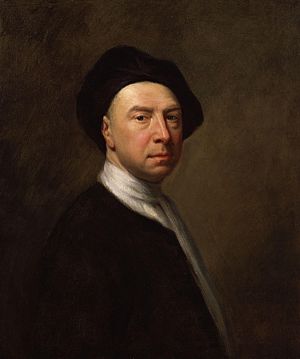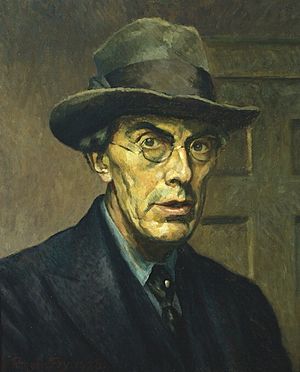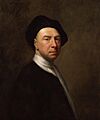Art criticism facts for kids
Art criticism is all about discussing and judging visual art. Think of it as talking about paintings, sculptures, and other artworks. People who do this are called Art critics. They often look at art based on its aesthetics, which means how beautiful or pleasing it is.
One main goal of art criticism is to find good reasons for why we like or dislike certain art. But it's also true that what critics say can be influenced by the world around them, like politics or society at the time.
There are many different types of art, like Impressionism or Cubism. Because of this, art criticism has also split into different areas. Each area might use different rules to judge art. For example, some critics look at art from the past, which is a bit like art history. Others focus on new art made by artists who are still alive today.
It might seem like art criticism is easy, but judging art can be tricky. What people think is great art today might be seen differently in the future. Sometimes, critics in the past made fun of artists who are now famous, like the early Impressionists. In fact, some art movements even got their names from critics who were trying to insult them! But later, the artists proudly used those names, and the original negative meaning was forgotten.
Artists and critics don't always get along. Artists often need good reviews from critics so their work gets seen and bought. But sometimes, people only truly understand an artist's work much later, after the artist is gone.
Art is a huge part of being human. You can find it in every culture and time period. Many things can change how someone judges art, like how it looks (aesthetics) or how we understand it. Art can be seen as objective (based on facts) or subjective (based on personal feelings). It can follow design rules or be shaped by what society and culture accept. Art is a basic human need, and it comes in many forms and ways of expressing feelings. You can judge art instantly, or you can learn more about it to understand it better.
Contents
What is Art Criticism?
Art criticism has many different ideas and opinions, almost as many as there are people doing it! It's hard to find one simple definition. But generally, it means talking about art, explaining what it means, and deciding how valuable it is. Sometimes, art criticism even includes art history.
No matter how you define it, art criticism often looks at the history of art. And art history itself can use critical ways of thinking. Art historian R. Siva Kumar said that the lines between art history and art criticism are not as clear as they used to be. He thinks this started when art historians became interested in modern art.
How Do Art Critics Work?
When an art critic looks at a piece of art, they first describe it. They put the artwork into words so they can explain their ideas about it. After describing it, or sometimes while describing it, they judge the art. This judgment depends on both the artwork itself and the critic's own experiences.
Since judging art can be very personal, there are many ways to do it. Some critics might just talk about their first feelings when they see an artwork. Others prefer a more organized way. They might use their knowledge of art techniques, their favorite ideas about beauty, and what they know about the artist's life and culture. This helps them understand what the artist was trying to do.
The History of Art Criticism
People have probably been talking about and judging art for as long as art has existed. We can find early forms of art criticism in old writings from thinkers like Plato and Vitruvius. Also, rich people who paid for art, called patrons, have used art evaluators since the Renaissance. These evaluators helped them choose artists and buy finished artworks.
How Art Criticism Started

Art criticism as a specific type of writing began in the 1700s. The English painter Jonathan Richardson first used the phrase "art criticism" in his book from 1719. It was called An Essay on the Whole Art of Criticism. In this book, he tried to create a fair system to rank artworks. He gave scores for things like drawing, how the art was put together, and colors. These scores were then added up for a final grade.
The term "art criticism" quickly became popular. This was especially true as the English middle class started buying more art to show off their social status.
In France and England in the mid-1700s, more people became interested in art. Art shows, called Salons in Paris and Summer Exhibitions in London, became regular events. The first writers to become known as art critics in France were Jean-Baptiste Dubos and Étienne La Font de Saint-Yenne. Dubos wrote about ideas of beauty, and Voltaire praised his work. Saint-Yenne wrote about the Salon of 1746. He even talked about how society and money affected the popular Baroque art style. Some people thought his writings were against the king.
The French writer Denis Diderot greatly improved art criticism in the 1700s. His "The Salon of 1765" was one of the first times someone truly tried to describe art using words. Art historian Thomas E. Crow said that Diderot started writing art criticism after the first group of professional writers began describing and judging art. People wanted these comments because art shows were becoming regular, free, and open to everyone.
Around the same time in England, art shows led to many critical writings. Newspapers like the London Chronicle started having columns for art criticism. This became even more popular after the Royal Academy was founded in 1768. In the 1770s, the Morning Chronicle became the first newspaper to regularly review art from exhibitions.
Art Criticism in the 1800s

From the 1800s onwards, art criticism became a more common job. Sometimes, critics even developed formal ways of judging art based on specific ideas about beauty. In France, a disagreement started in the 1820s. It was between those who liked traditional neo-classical art and those who preferred the new romantic style.
The Neoclassicists, led by Étienne-Jean Delécluze, liked classical ideas and paintings with very careful details. Romantics, like Stendhal, said the old styles were too strict and had no feeling. Instead, they supported the new, emotional, and expressive Romantic art. A similar, but quieter, debate also happened in England.
One important critic in England was William Hazlitt. He was a painter and writer. He wrote about how much he loved art and believed that art could make people kinder and help them understand the world better. He was one of many English critics who started to worry about how abstract J. M. W. Turner's landscape paintings were becoming.
One of the greatest critics of the 1800s was John Ruskin. In 1843, he published Modern Painters. This book talked about the difference between "things seen by the artist" and "things as they are." Ruskin was known for his beautiful writing. Later in his life, he also wrote about architecture and Renaissance art, including The Stones of Venice.

Another major figure in 19th-century art criticism was the French poet Charles Baudelaire. His first published work was his art review Salon of 1845, which quickly got attention because it was so bold. Many of his ideas were new at the time, like his support for Eugène Delacroix. He believed that "criticism should be partial, passionate, political." He tried to move the discussion beyond old arguments. He said that a true painter would be someone who could show the amazing side of everyday life.
In 1877, John Ruskin strongly criticized a painting called Nocturne in Black and Gold: The Falling Rocket by James McNeill Whistler. Ruskin said, "I have seen... much of Cockney impudence before now; but never expected to hear a coxcomb ask two hundred guineas for flinging a pot of paint in the public's face." This led Whistler to sue Ruskin for libel. Whistler won the case, but it cost him a lot.
Early 1900s Art Criticism

By the late 1800s, artists started moving towards abstraction, which means art that doesn't show specific things. This idea gained popularity in England, especially with the writer Oscar Wilde. In the early 1900s, these ideas became a clear philosophy through the work of Bloomsbury Group members Roger Fry and Clive Bell.
Roger Fry, an art historian in the 1890s, became very interested in new modernist art. He liked how it moved away from traditional ways of showing things. In 1910, he held an exhibition of what he called post-Impressionist art. Many people criticized it for being too different. Fry strongly defended his choices. He said that art was trying to find a language of pure imagination, instead of just trying to copy landscapes scientifically. Fry's ideas were very important at the time, especially among modern thinkers.
At the same time, Clive Bell wrote in his 1914 book Art that all artworks have a special "significant form." He believed that the usual subject of a painting was not important. This idea helped create the formalist way of looking at art. In 1920, Fry said that it didn't matter to him if he painted a Christ or a saucepan, because he was interested in the shape, not the object itself. He also believed that art's value came from its ability to create a special feeling in the viewer, which he called "aesthetic emotion." He thought this feeling came from seeing the "significant form" in art.
Herbert Read supported modern British artists like Paul Nash, Ben Nicholson, Henry Moore, and Barbara Hepworth. He focused on the modernism of Pablo Picasso and Georges Braque. He also helped organize the London International Surrealist Exhibition in 1936.
Art Criticism Since 1945
Just like in the 1800s with Baudelaire, poets became art critics again in the 1900s. The French poet Apollinaire became a big supporter of Cubism. Later, the French writer André Malraux wrote a lot about art. He thought that Mexican Muralism (by artists like Orozco, Rivera, and Siqueiros) was the most exciting new art in Latin America. But after visiting Buenos Aires in 1958, he changed his mind. He then said that the new and exciting art was coming from Argentina.
In the 1940s, there were not many art galleries or critics who supported the new New York Vanguard artists. Some artists, like Robert Motherwell and Barnett Newman, also worked as critics.
By the late 1940s, many artists who are famous today had critics who supported them. Clement Greenberg was a big supporter of Jackson Pollock and color field painters like Mark Rothko. Harold Rosenberg seemed to prefer "action painters" like Willem de Kooning. Thomas B. Hess, who managed ARTnews magazine, also championed Willem de Kooning.
These new critics often praised their favorite artists while ignoring others. For example, in 1958, Mark Tobey won a top art prize in Venice. But New York's two main art magazines barely mentioned it or ignored it completely.
Barnett Newman also wrote about art and became an exhibiting artist. He worked hard to build his image as an artist and promote his own work. He once said, "We are in the process of making the world, to a certain extent, in our own image."
Clement Greenberg was a very important art critic for magazines like Partisan Review. He strongly supported Abstract Expressionism and Jackson Pollock. Greenberg believed Pollock's work was the best painting of its time. He saw it as the peak of an art tradition that focused on making painting "purer" by concentrating on marks on a flat surface.
Jackson Pollock's art always caused strong opinions among critics. Harold Rosenberg said that Pollock's work turned painting into a dramatic event. He felt that "what was to go on the canvas was not a picture but an event."
Some critics, like John Canaday from The New York Times, were very critical of Abstract Expressionism. But others, like Meyer Schapiro and Leo Steinberg, supported it. Later, younger critics like Michael Fried and Rosalind Krauss also added important ideas to the discussion about Abstract Expressionism.
Feminist Art Criticism
Feminist art criticism started in the 1970s as part of the larger feminist movement. It looks closely at how women are shown in art and at art made by women artists. This is still a very important area of art criticism today.
Art Criticism Today
Today, art critics work in many places. You can find their writings in newspapers and special art magazines. They also appear on the internet, TV, and radio. Many critics work in museums or teach art at universities. Art critics often help organize art shows and write the books that go with them.
Art critics even have their own international group called the International Association of Art Critics. It has sections in many countries around the world.
Art Blogs
Since the early 2000s, many art criticism websites and blogs have appeared online. These writers share their ideas about art criticism using social media like Facebook and Twitter.
See also
 In Spanish: Crítica de arte para niños
In Spanish: Crítica de arte para niños
- Art history
- Art critic
- Documenta 12 magazines (examples of modern art criticism)
Images for kids
-
Jonathan Richardson coined the term 'art criticism' in 1719.
-
John Ruskin, the preeminent art critic of 19th century England
-
Charles Baudelaire's Salon of 1845 art review shocked its audience with its ideas.
-
Self portrait of Roger Fry, described by the art historian Kenneth Clark as "incomparably the greatest influence on taste since Ruskin... In so far as taste can be changed by one man, it was changed by Roger Fry".






